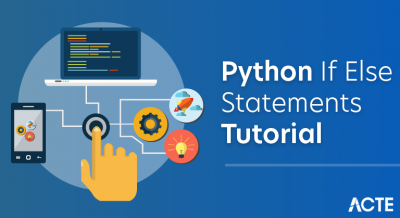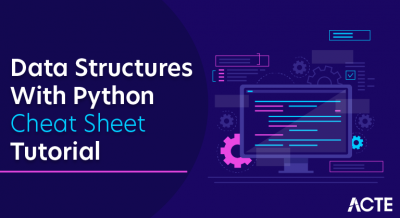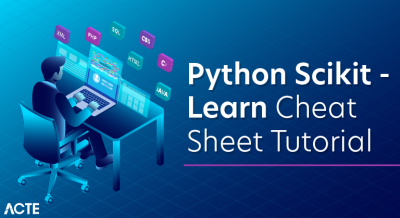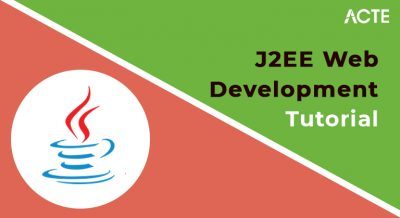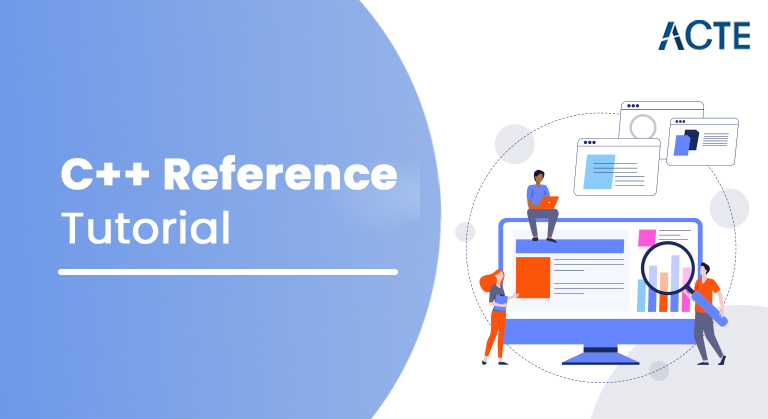
- Introduction to C++ Reference
- Making References in C++
- An Aside on Commenting Your Programs
- Client communication and Saving Information with Variables
- For what reason to Learn C++
- Hi World utilizing C++
- Utilizations of C++ Programming
- Object-Oriented Programming
- Learning C++
- Application of C++
- C++ Class Definitions
- Characterize C++ Objects
- The Process of Writing a C++ Program
- What is a Variable?
- References for Built-in Types
- Benefits of reference factors over pointer factors in C++
- Conclusion
- You can’t have NULL references. You should be capable all of the time to expect that a reference is associated with a real piece of capacity.
- When a reference is introduced to an item, it can’t be changed to allude to another article. Pointers can be highlighted one more item whenever.
- A reference should be introduced when it is made. Pointers can be introduced whenever.
- int I = 17;
- We can proclaim reference factors for I as follows.
- int& r = I;
- As you are figuring out how to program, you ought to likewise begin to figure out how to clarify your projects (for yourself’s purposes, if no other person). You do this by adding remarks to code; I’ll utilize them now and again to assist with clarifying code models.
- At the point when you tell the compiler a part of the text is a remark, it will overlook it when running the code, permitting you to utilize any text you need to depict the genuine code. To make a remark use either//, which lets the compiler know that the remainder of the line is a remark, or/* and afterward */to close off everything between as a remark. Certain compiler conditions will change the shade of a remarked region, however, some will not.
- Be sure not to coincidentally remark out code (that is, to tell the compiler some portion of your code is a remark) you want for the program. At the point when you are figuring out how to program, it is helpful to have the option to remark out areas of code to perceive how the result is impacted.
- Up to this point you’ve figured out how to compose a straightforward program to show data composed by you, the software engineer, and how to portray your program with remarks. That is extraordinary, however, what might be said about connecting with your client? Luckily, it is likewise feasible for your program to acknowledge input. The capacity you use is known as sin and is trailed by the extraction administrator
- Before you attempt to get input, you should have a spot to store that information. In programming, information and information are put away in factors. There are a few distinct sorts of factors which store various types of data (for example numbers versus letters); when you tell the compiler you are pronouncing a variable, you should incorporate the information type alongside the name of the variable. A few essential sorts incorporate burn, int, and float.
- A variable of type scorch stores a solitary person, factors of type int store (numbers without decimal spots), and factors of type float store numbers with decimal spots. Every one of these variable sorts – burn, int, and float – is each a watchword that you use when you announce a variable.
- C++ is extremely near equipment, so you get an opportunity to work at a low level which gives you part of control as far as memory the board, better execution lastly a powerful programming improvement.
- C++ programming gives you a reasonable comprehension about Object Oriented Programming. You will see low level execution of polymorphism when you will carry out virtual tables and virtual table pointers, or dynamic sort distinguishing proof.
- C++ is one of the each green programming dialects and cherished by a great many programming engineers. In the event that you are an incredible C++ software engineer, you won’t ever sit without work and all the more significantly you will get generously compensated for your work.
- C++ is the most broadly involved programming dialects in application and framework programming. So you can pick your area of interest of programming advancement.
- C++ truly shows you the contrast between compiler, linker and loader, various information types, stockpiling classes, variable sorts their extensions and so forth
- There are 1000s of valid justifications to learn C++ Programming. Yet, one thing without a doubt, to become familiar with any programming language, not just C++, you simply need to code, and code lastly code until you become master.
- Live Demo
- #incorporate <'iostream>
- utilizing namespace sexually transmitted disease;
- // primary() is the place where program execution starts.
- int principle() {
- cout << "Hi World";//prints Hello World
- bring 0 back;
- }
- Apple C++. Xcode
- Slaughter Dev-C++
- Thump C++
- Cygwin (GNU C++)
- Guide Graphics
- MINGW – “Moderate GNU for Windows”
- GNU CC source
- IBM C++
- Intel C++
- Microsoft Visual C++
- Prophet C++
- HP C++
- Exemplification
- Information stowing away
- Legacy
- Polymorphism
- Standard Libraries
- The center language giving all the structure blocks including factors, information types and literals, and so on
- The C++ Standard Library giving a rich arrangement of capacities controlling records, strings, and so on
- The Standard Template Library (STL) giving a rich arrangement of techniques controlling information structures, and so forth
- The ANSI standard is an endeavor to guarantee that C++ is compact; that code you compose for Microsoft’s compiler will arrange without blunders, utilizing a compiler on a Mac, UNIX, a Windows box, or an Alpha.
- The ANSI standard has been steady for some time, and all the major C++ compiler makers support the ANSI standard.
- The main thing while at the same time learning C++ is to zero in on ideas.
- The motivation behind learning a programming language is to improve as a developer; that is, to turn out to be more compelling at planning and carrying out new frameworks and at keeping up with old ones.
- C++ upholds an assortment of programming styles. You can write in the style of Fortran, C, Smalltalk, and so on, in any language. Each style can accomplish its points adequately while keeping up with runtime and space productivity.
- C++ is involved by a huge number of software engineers in basically every application area.
- C++ is by and large exceptionally used to compose gadget drivers and other programming that depend on direct control of equipment under realtime imperatives.
- C++ is generally utilized for educating and exploration since it is spotless enough for fruitful instructing of fundamental ideas.
- Any individual who has utilized either an Apple Macintosh or a PC running Windows has in a roundabout way utilized C++ in light of the fact that the essential UIs of these frameworks are written in C++.
- class Box {
- public:
- twofold length;//Length of a container
- twofold broadness;//Breadth of a container
- twofold tallness;//Height of a container
- };
- Box Box1;//Declare Box1 of type Box
- Box Box2;//Declare Box2 of type Box
- Both of the articles Box1 and Box2 will have their own duplicate of information individuals.
- PC programs control (or interaction) information. A variable is utilized to store a piece of information for handling. It is called variable since you can change the worth put away.
- All the more exactly, a variable is a named stockpiling area, that stores a worth of a specific information type. All in all, a variable has a “name”, a “type” and stores a “esteem” of that kind.
- A variable has a “name” (or identifier), e.g., range, region, total. The name is expected to exceptionally recognize and reference a variable, to allot a worth to the variable (e.g., radius=1.2), and recover the worth put away (e.g., region = radius*radius*PI).
- A reference is a moniker for an item. C++ reference permits us to make another name for a current article. It additionally permits us to control an article along these lines of utilizing pointer without pointer linguistic structure.
- By and by, references are fundamentally utilized as boundaries to a capacity, for example, an article passed into a capacity. Yet, in this part we’ll just arrangement with references for worked in types.
- A reference should be instated. When characterized, a reference can’t be made to allude to another item and for this reason it should be introduced.
- int ival = 128;
- int &refval; = ival; //refval is a reference to ival
- int &refval2; //Error: a reference should be instated
- A reference variable doesn’t consume any additional memory. It has a similar memory address as the variable it alludes to. While a pointer needs additional room for itself.
- To get to the worth of the referred to variable utilizing pointer, we want to utilize a dereferencing operator(*) while we can do a similar utilizing reference variable with next to no dereferencing strategy.
Introduction to C++ Reference
A reference variable is a pseudonym, that is, one more name for a generally existing variable. When a reference is introduced with a variable, either the variable name or the reference name might be utilized to allude to the variable.
References versus Pointers
References are regularly mistaken for pointers however three significant contrasts among references and pointers are −
Making References in C++
Consider a variable name a mark connected to the variable’s area in memory. You can then consider a reference a subsequent mark connected to that memory area. In this way, you can get to the substance of the variable through either the first-factor name or the reference. For instance, assume we have the accompanying model −
Peruse the and in these announcements as reference. In this manner, read the main statement as “r is a number reference instated to I” and read the second affirmation as “s is a twofold reference introduced to d.”. The following model utilizes references on int and twofold −
An Aside on Commenting Your Programs
Client communication and Saving Information with Variables
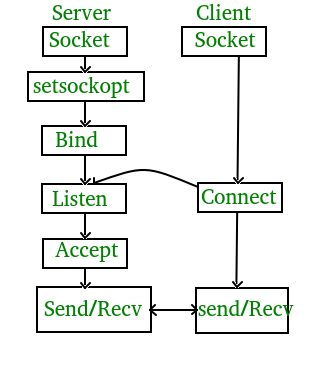
For what reason to Learn C++
C++ is a center level programming language created by Bjarne Stroustrup beginning in 1979 at Bell Labs. C++ runs on an assortment of stages, like Windows, Mac OS, and the different renditions of UNIX. This C++ instructional exercise takes on a basic and functional way to deal with portray the ideas of C++ for amateurs to advanded computer programmers. C++ is a MUST for understudies and working experts to turn into an extraordinary Software Engineer. I will list down a portion of the vital benefits of learning C++:
Hi World utilizing C++
Just to give you a little fervor about C++ writing computer programs, I will give you a little regular C++ Hello World program, You can attempt it utilizing Demo interface. C++ is a very arrangement of C programming with extra execution of item situated ideas.
There are numerous C++ compilers accessible which you can use to incorporate and run previously mentioned program:
It is truly difficult to give a total rundown of the multitude of accessible compilers. The C++ world is simply too enormous and a lot of new is going on.
Utilizations of C++ Programming
As referenced previously, C++ is quite possibly the most generally utilized programming language. It has it’s essence in pretty much every area of programming advancement. I will list not many of them here:
Application Software Development – C++ programming has been utilized in growing practically every one of the major Operating Systems like Windows, Mac OSX and Linux. Aside from the working frameworks, the center piece of numerous programs like Mozilla Firefox and Chrome have been composed utilizing C++. C++ additionally has been utilized in fostering the most well known data set framework called MySQL.
Programming Languages Development – C++ has been utilized widely in growing new programming dialects like C#, Java, JavaScript, Perl, UNIX’s C Shell, PHP and Python, and Verilog and so on
Calculation Programming – C++ is the closest companions of researchers due to quick speed and computational efficiencies.
Games Development – C++ is amazingly quick which permits software engineers to do procedural programming for CPU escalated works and gives more noteworthy command over equipment, due to which it has been broadly utilized being developed of gaming motors.
Implanted System – C++ is by and large vigorously utilized in creating Medical and Engineering Applications like virtual products for MRI machines, top of the line CAD/CAM frameworks and so on
This rundown continues, there are different regions where programming designers are cheerfully utilizing C++ to give incredible virtual products. I strongly prescribe you to learn C++ and contribute extraordinary programming projects to the local area.
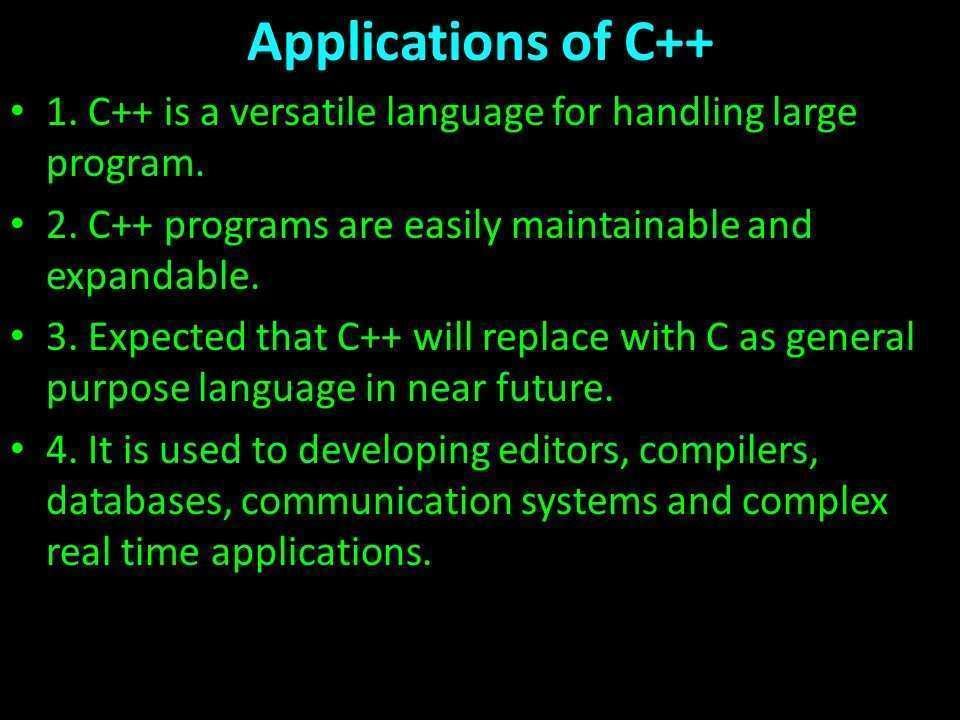
Object-Oriented Programming
C++ completely upholds object-situated programming, including the four mainstays of item arranged turn of events −
Standard C++ comprises of three significant parts −
The ANSI Standard
Learning C++
Application of C++
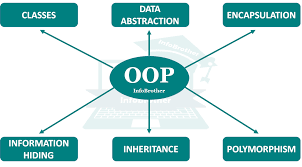
C++ Class Definitions
At the point when you characterize a class, you characterize an outline for an information type. This doesn’t really characterize any information, yet it characterizes what the class name implies, that is, what an object of the class will comprise of and what tasks can be performed on such an article.
A class definition begins with the catchphrase class followed by the class name; and the class body, encased by a couple of wavy supports. A class definition should be followed either by a semicolon or a rundown of affirmations. For instance, we characterized the Box information type utilizing the catchphrase class as follows −
The catchphrase public decides the entrance credits of the individuals from the class that follows it. A public part can be gotten to from outside the class anyplace inside the extent of the class object. You can likewise indicate the individuals from a class as private or secured which we will talk about in a sub-segment.
Characterize C++ Objects
A class gives the outlines to objects, so fundamentally an item is made from a class. We proclaim objects of a class with the very same kind of presentation that we pronounce factors of essential sorts. Following proclamations announce two objects of class Box −
C++ Terminology and Syntax
Proclamation: A programming articulation plays out a piece of programming activity. It should be ended by a semicolon (;) (very much like an English sentence is finished with a period), as in Lines 5, 8 and 9.
Preprocessor Directive: The #include (Line 4) is a preprocessor order and NOT a programming proclamation. A preprocessor mandate starts with hash sign (#). It is handled prior to gathering the program. A preprocessor mandate isn’t ended by a semicolon – observe this strange rule.
Block: A square is a gathering of programming explanations encased by supports { }. This gathering of proclamations is treated as one single unit. There is one square in this program, which contains the body of the principle() work. There is no compelling reason to put a semicolon after the end support.
Remarks: A multi-line remark starts with/* and closes with */, which might traverse more than one line. A finish of-line remark starts with//and keeps going till as far as it goes. Remarks are NOT executable articulations and are disregarded by the compiler; however they give valuable clarification and documentation. Use remarks generously.
Whitespaces: Blank, tab, and newline are on the whole called whitespaces. Extra whitespaces are overlooked, i.e., only one whitespace is expected to isolate the tokens. In any case, additional blank areas and newlines could assist you and your perusers with bettering comprehend your program. Utilize extra whitespaces and newlines generously.
Case Sensitivity: C++ is case delicate – a ROSE is definitely not a Rose, and is anything but a rose.
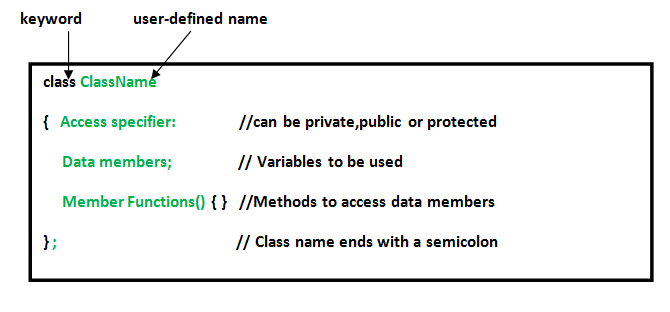
The Process of Writing a C++ Program
Stage 1: Write the source codes (.cpp) and header records (.h).
Stage 2: Pre-process the source codes as indicated by the preprocessor orders. Preprocessor orders start with a hash sign (#), e.g., #include and #define. They show that specific controls, (for example, including one more record or substitution of images) are to be performed BEFORE aggregation.
Stage 3: Compile the pre-handled source codes into object codes (.obj, .o).
Stage 4: Link the accumulated article codes with other item codes and the library object codes (.lib, .a) to create the executable code (.exe).
Stage 5: Load the executable code into PC memory.
Stage 6: Run the executable code, with the contribution to deliver the desried yield.
What is a Variable?
A variable has a “type”. Instances of type are:
int: for numbers (entire numbers, for example, 123 and – 456;
twofold: for drifting point or genuine numbers, for example, 3.1416, – 55.66, 7.8e9, 1.2e3, – 4.5e-6 having a decimal point and partial part, in fixed or logical documentations.
References for Built-in Types
The references that we’ve been utilizing up until this point are lvalue references-references to lvalues. The term lvalue alludes to things that can be on the left half of a task articulation, for example, named articles or items dispensed on the stack or pile things with a characterized stockpiling area. The term rvalue alludes to things that can happen just on the right half of a task articulation, for example, literals and substitutes which are planned to never be modifiable. The lvalue references must be bound to lvalues yet not rvalues.
Benefits of reference factors over pointer factors in C++
This instructional exercise is about the upsides of reference factors over pointer factors in C++. A reference variable is a pseudonym for a variable though a pointer variable focuses to a location involved by some factor. We should see how a reference variable can be a superior choice in certain situations against the pointer factors.
A reference variable is a second name for a variable and can be utilized anyplace in the program as the first factor. A pointer variable is a variable that focuses to the location of a variable.
There are many benefits of utilizing reference factors over pointer factors, for example,
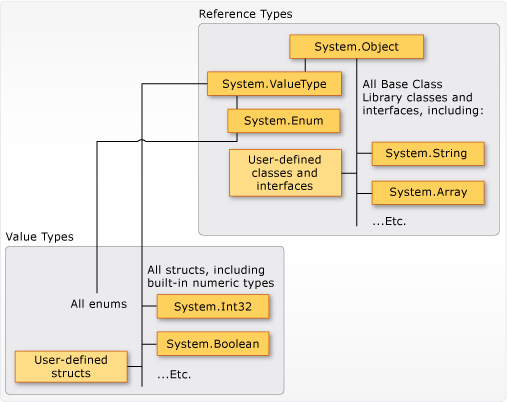
Conclusion:
I have introduced the rudiments for you to get start in programming. To master programming, you want to comprehend the sentence structures and highlights associated with the programming language that you picked, and you need to practice, practice and practice, on however many issues as you could.


